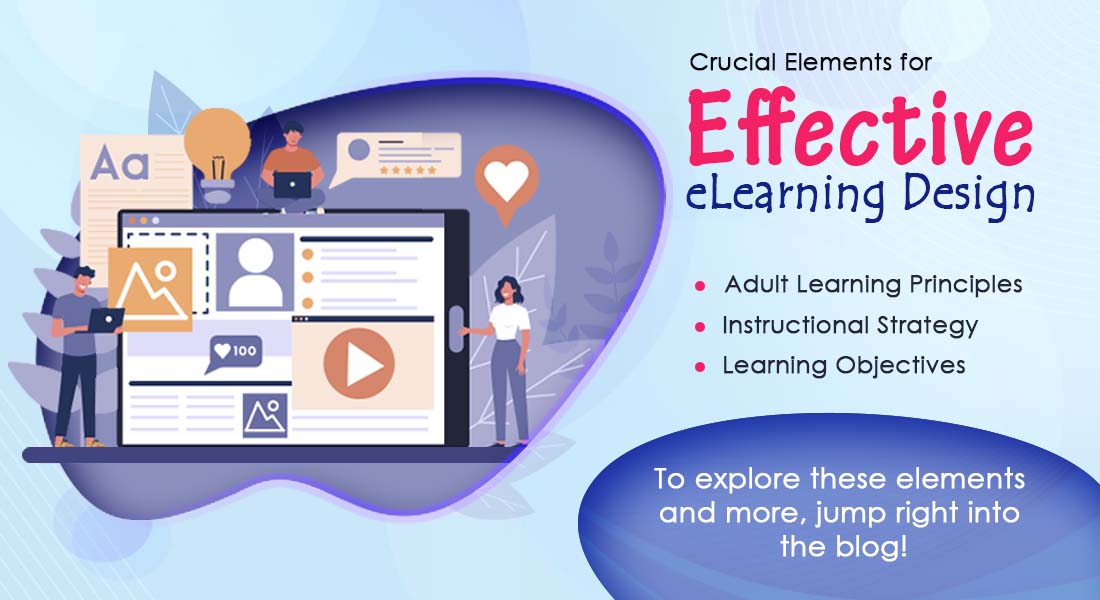Top 5 Elements of Effective Learning to Design a Learner-Centric eLearning Course

Irrespective of age, learning is an integral part of life and growth. It leads to both personal and professional gains. Learning can occur via different mediums and at multiple levels. However, doing justice to the idea of learning can be way more difficult than it seems. In this blog, we are going to focus on the essential elements of effective learning that, in turn, will help you develop a successful eLearning course as part of an established company that yields the desired outcome. Let’s get started!
Wondering About What Might Work Best for Your eLearning Course?
Here are the top five elements of effective learning pivotal to designing an eLearning course.
- Motivation
- Stimulus
- Response
- Practice and Reinforcement
- Reward
The process of learning can be divided into three parts: retention, comprehension, and application. Retention means remembering what you’ve learned, comprehension means understanding it, and application means applying what you’ve learned in your daily life. All three parts are necessary for effective learning.
What is Effective Learning?
Effective learning entails understanding why people do what they do in a job-related situation, how to improve performance, and limits on specific tasks. Learning is essentially the process by which individuals acquire knowledge and skills relating directly or indirectly to responsibilities or occupations.
Well, learning can be a challenging thing, for it involves multiple factors that contribute to its fruition or failure. It’s hard to come up with a training course that actually works—and even harder to make sure that it does. But there are some key elements of effective learning that can help you get started on the right foot.
5 Elements of Effective Learning
Designing an eLearning course is both, an art and a science. Good trainers use their experience to create an engaging learning experience for their students. They understand how to tell stories, structure lessons, and ensure that each lesson leads to the next in an effort to prepare learners for success. Regardless, some elements form the core of effective learning and must be incorporated in designing the training course. They are:
Motivation
If you want to require your employees to learn to handle the various challenges of their job roles, it is imperative that they are motivated to learn. It is the primary reason why a learner would want to attend the training course in the first place. Motivation can stem from a variety of things—a desire to gain more knowledge about a particular field or acquire a new skill—but it must exist in the learner’s mind before they even start the training. You may have a great course that takes a lot of effort to make and train people how to do things right. However, most people will leave your course without remembering any of it because they just don’t feel motivated or engaged by what you’re saying.
So it is of utmost importance to design your eLearning course in a manner that motivates the learner to pay attention. It should add value to their pre-existing skills and knowledge that helps them make progress in their career.
Stimulus
When designing a course, this component decides the fate of the learning process. At times, even the highly motivated learner might not benefit from the course if it is not structured and organized properly. The stimulus is what gets the learner engaged in their learning experience. And for training purposes, the course material provided is the magnum opus. It might be a video lecture or an interactive assignment that encourages critical thinking and problem-solving skills. If it’s synchronous virtual collaboration, it can also be something less tangible, like asking questions during the session.
Well, if this was a stimulus for you to know more about eLearning, check it out here!
Response
With the best efforts in place, the response of the learner is an important factor in analyzing the success of the learning process. It reflects how learners respond to the given stimulus by either applying it or not applying it (i.e., whether they engage with the material). For example, if you wish to know about the effectiveness of your eLearning course on data privacy, you can check it by monitoring if the employees start locking their computer screens when not in use, use encrypted sources to share confidential information, etc., which affirms the positive impact of training.
Practice and reinforcement
Practice and reinforcement are both ways of making sure that the learners get comfortable to a point with what they have learned that it almost becomes a part of their automatic behavior. Rehearsing via different eLearning assessments also boosts their confidence level, which facilitates more learning opportunities. Practice should always happen at regular intervals throughout a training course, especially if there’s a test at the end of it or anything where success will be determined by whether or not someone has a clear understanding of what was being conveyed to them.
For practice at regular intervals, you can include the formative assessment in the eLearning course which will help you ensure that the learners have a basic idea of what is being conveyed to them and are ready to move ahead to the next piece of information. However, to gain an idea of the overall knowledge attained by the learners during the training course, you can incorporate summative assessment into the training module.
Reward
A reward is a major driving factor in fostering effective learning. It forms a part of external motivation where on completion of the assigned task, a person gains something favorable to their interest. Rewards can be in the form of promotions, incentives, gift hampers, discount coupons, an acquired skill that provides better opportunities, and more. They act as little tokens of achievements that make the learner feel good about themselves and the undertaken course to promote effective knowledge transfer with eLearning. In fact, it also gives them a push to try new and better things, thereby fulfilling the objective of effective learning.
Therefore, it is vital to make sure that your course is rewarding in terms of learning and value addition for anyone who opts for the course.
Wrapping up
People learn in different ways: some are visual learners, while others are auditory or kinesthetic. No matter what your preference is, you need to make sure that it doesn’t hinder the effectiveness of your eLearning course. Good training is not just about giving training. It is an integral part of the learning process. It is highly effective when it is fun and interesting, motivating, stimulating, and provides variety. These elements are all essential to creating an eLearning course that will be engaging for learners and successful for instructors.
For a reality check, you can go through our webinar recording to make sure your training material will actually leave the impact you’re expecting it to. It covers key considerations for high-impact eLearning to guide you in the right direction.





